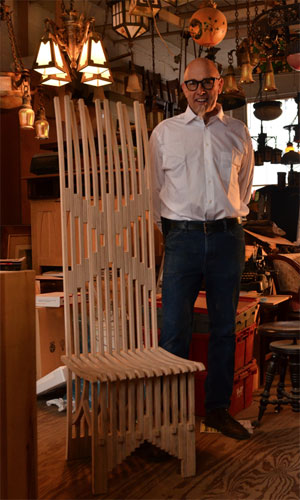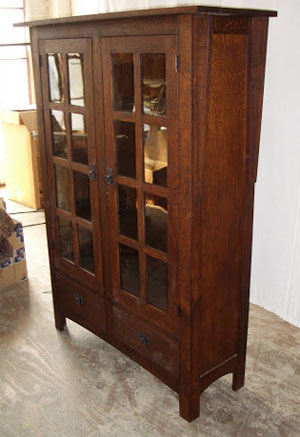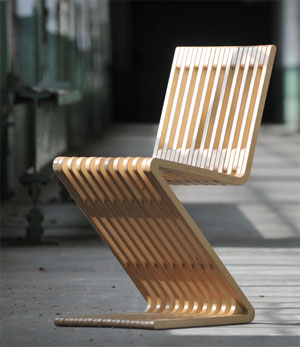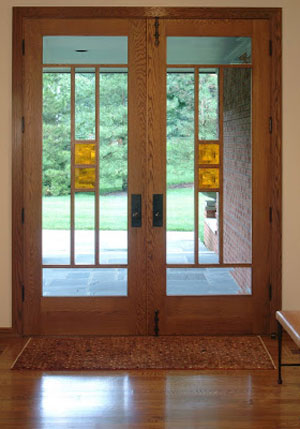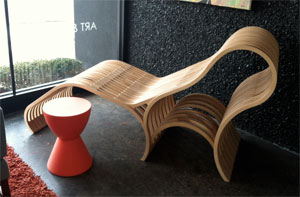
Alan Kaniarz had “always been a handy kid, taking things apart and making things,” and gaining more mechanical learning from hanging out at the gas station across the street from his youthful home. Spending a few years working as a welder with roll framing equipment — making things like guard rails, and gutters on houses — “taught me precision; we worked within 1,1000ths of an inch tolerance,” Alan said.
After that, he went to work for a company that had offered a stained glass class he had taken and been interested in, eventually working his way up to be vice president of the stained glass manufacturing company (and repairing Tiffany and LaFarge pieces along the way). After parting ways with that company over a difference of principle with the owner, Alan got his builder’s license and planned to work on houses, “but I was drawn to be a woodworker,” he said. “I would make a little money, and buy a tool.”
Setting up shop, at first as part of a group, then by himself (those who’ve had roommates, Alan said, know how it is, “when you come home expecting tofind the beer in the refrigerator and it wasn’t”), Alan has made doors, traditional kitchen cabinets, and furniture, restored and repaired furniture, and bought and sold antiques, as well as doing a little bit of metalwork.
His primary focus is on woodworking, though; most recently, on a line of modern furniture he’s designed. “Until a couple of years ago, I was doing mostlyreproduction work, a lot of Arts and Crafts, but my attraction these days is to modern — although Arts and Crafts is the beginning of modern furniture,” Alan said.
“There’s something visually stimulating about the lines of modern furniture. It has an organic nature to it that I find to be particularly appealing. With the classic mid-century designs — the Eames chair, Saarinen, Herman Miller — there’s something pretty appealing about the spare amount of material that ends up in a visually appealing piece of furniture.”
Alan himself designed one chair that uses only four pieces of wood, and, in his “mobel” (a European word that means “furniture”) line, “even though there’s a number of pieces” per item, “it’s not a lot of wood.” In fact, that’s part of the appeal for him: “We can build an entire chair, with 80 to 90 piees, and we can cut all the pieces out of a single sheet of plywood. We end up using 90 to 95 percent of a sheet, and the amount of waste is minimal at best.”
The plywood that Alan’s speaking of for this line is Baltic birch plywood, which he likes because it’s dimensionally stable and has a great weight to strength ratio. “We could make the pieces out of solid wood, but wood is a hygroscopic material; it takes on and gets rid of moisture and expands and contracts, so we would use a lot of wood, and the chair would eventually expand and contract itself apart.” Also, Alan said, there are no mineral stains, no big voids, and the edges are attractive — “the edgework ends up looking like quartersawn wood, with rings on the edges.”
Alan and his three employees use the CAD/CAM system for this line of furniture, creating computer assisted drawings in the TurboCAD program to show what all the parts of a piece of furniture will look like, and how they will fit, then creating a drawing exchange file and transferring it those who are cutting the pieces for the furniture with a computer assisted manufacturing system.
Furniture created for this line has included chairs like the flagship Quarnge (it rhymes with “orange”) and the Zag Zig Chair (a take-off on a 1933 Zig-Zag Chair by Gerrit Reitveld). “It looks fragile, but I had a fellow who told me he weighed 365 pounds who was able to sit in it and rock in it,” Alan said. All of the pieces are designed to be comfortable, which sometimes requires some redesigning. “It’s the art of trial and error. Something might look good on paper, but it was a torture device when it turned out.”
Since he has the assistance of his employees, Alan says he gets to pick and choose what aspects of the hands-on work he’s involved with, picking things thatparticularly interest him. He’s very involved in the design aspect, for instance, and he also likes finishing, “applying the various finishes and coming up with the stain and color combinations. A piece of furniture isn’t finished until it has finish on it.” These days, most of his items are finished with two-part post-catalyzed lacquer, which Alan appreciates as being “way more water- and chemical-resistant” than the older nitrocellulose lacquers. Sometimes, he’ll use shellac as a sanding sealer, in order to impart the subtle “cat’s-eye” shimmer of chatoyance.
He also keeps his hand in with stained glass because, he says, it goes hand in hand with woodworking — there might be glass sidelights on transoms on a door, leaded glass in the doors of kitchen cabinets, or leaded windows in the lower cabinets of a library installation. “I’ve been doing glass work since 1975,” Alan said. “It’s all done in the same shop.”
He also has a collection of over 100 pieces of antique lighting form the Philadelphia-based John L. Gaumer Company, which existed from 1882 to 1952. Although Alan says their quality is comparable to Tiffany and others, the company relied on a paper hanging tag to identify its products, with “the result that almost no one knows about the company. I think I’m the world expert on this missing chapter in the Arts and Crafts movement story,” Alan said.
Alan, who also teaches at an art college, elaborated on his point about Arts and Crafts being the beginning of a modern design: “The modern movement,” he said, “started as retaliation against the overornamentation of the Victorian period, where things were carved and ornamented and fringed with all sorts of gewgaws superfluous to the design.”
That’s not his taste. Instead, Alan said, he likes things, like his modern furniture, “with interesting lines to it.”
